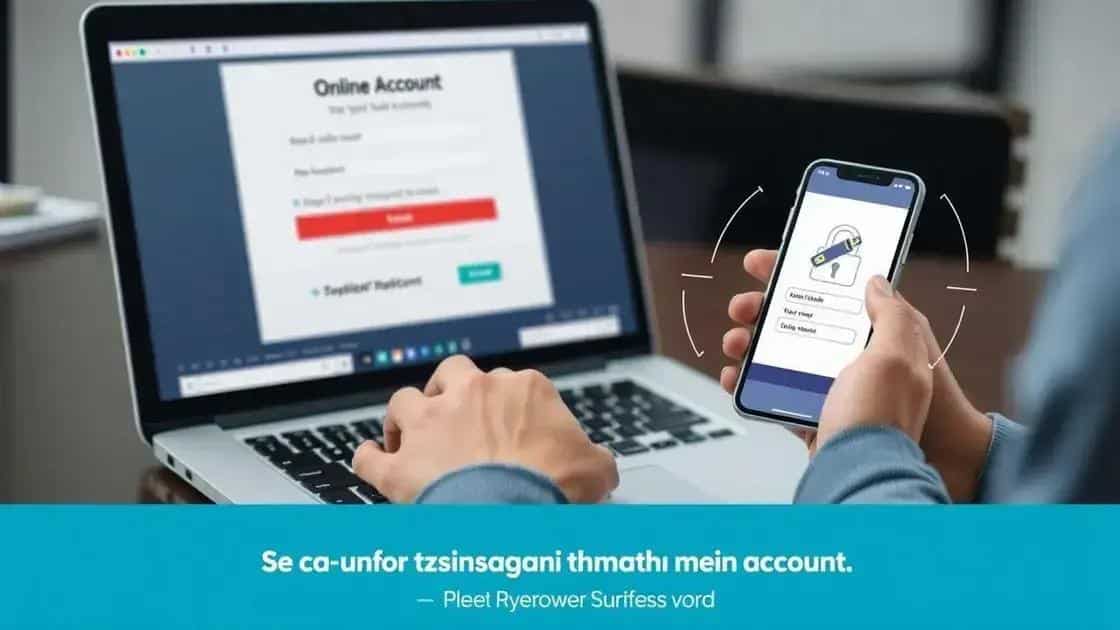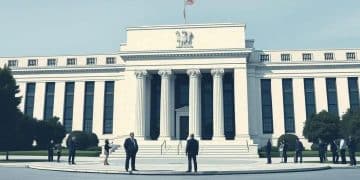Over online banking safety: how to protect your funds

To ensure online banking safety, use strong passwords, enable multi-factor authentication, recognize phishing attempts, and promptly report any breaches to your bank.
Over online banking safety is becoming an essential topic for many users today. With the surge in online transactions, how can you ensure your finances remain protected? Let’s delve into some essential strategies to safeguard your accounts.
Understanding online banking threats
Understanding online banking threats is essential in today’s digital landscape. With more people using online banking, it’s crucial to know the security risks involved.
Types of Online Banking Threats
Online banking faces various threats, and being aware of them can help you protect your finances. Common threats include:
- Phishing: Fraudulent emails or messages that trick you into revealing personal information.
- Malware: Software designed to harm or exploit your devices, often used to steal your banking credentials.
- Man-in-the-middle attacks: When hackers intercept communications between you and your bank.
- Credential stuffing: Using stolen usernames and passwords from other sites to access your bank account.
These threats can lead to identity theft and financial loss, making understanding them vital. For example, phishing attacks can look extremely convincing, often mimicking legitimate bank communications. It’s important to exercise caution with any unsolicited emails or messages.
Malware can also be tricky. It can get onto your device without you knowing, capturing your keystrokes or monitoring your activity. Regularly updating your antivirus software can help mitigate these risks.
Recognizing Warning Signs
Learning to recognize warning signs can greatly enhance your online security. If you notice strange transactions or receive unexpected alerts, it could indicate a security issue. Always report suspicious activity to your bank immediately.
Be proactive in securing your accounts. Using multi-factor authentication adds an extra layer of protection, making it harder for potential threats to access your information.
Finally, educate yourself on safe password practices. A strong, unique password is your first defense against unauthorized access.
Best practices for secure online banking
Best practices for secure online banking can help you protect your financial information. By following these simple guidelines, you can minimize risks and enjoy a safer banking experience.
Use Strong Passwords
Your password is your first line of defense. Ensure it is strong, consisting of at least 12 characters, and includes a mix of letters, numbers, and symbols. Avoid using easily guessed information, like birthdays or names.
- Change passwords regularly: Update your passwords every few months.
- Avoid reuse: Don’t use the same password across different accounts.
- Consider a password manager: These tools can help you generate and store strong passwords securely.
In addition to strong passwords, enable multi-factor authentication (MFA) whenever possible. This adds an extra layer of security by requiring a second form of verification, such as a code sent to your phone.
Stay Vigilant Against Phishing
Phishing is a common tactic used by fraudsters. Always scrutinize emails or messages that ask for your personal information. If something seems off, do not click on links or provide any details.
Check for signs of phishing, like poor spelling and grammar or unfamiliar sender addresses. If in doubt, contact your bank directly to verify any requests.
Always log into your account directly through the bank’s website or app instead of clicking links in emails. This ensures you are accessing the legitimate site.
Secure Your Devices
Your devices must also be secure to protect your banking information. Keep your software and apps updated regularly to guard against vulnerabilities.
- Use antivirus software: It helps protect against malware and other threats.
- Secure your connection: Avoid using public Wi-Fi networks for banking transactions.
- Log out: Always log out of your online banking session when you are done.
By implementing these best practices, you create a robust shield around your online banking activities, making it much harder for attackers to get through.
How to recognize phishing attempts

Recognizing phishing attempts is crucial for protecting your online banking information. Cybercriminals often use clever tactics to trick you into revealing your personal and financial details.
Common Signs of Phishing
There are several indicators that can help you identify potential phishing attempts. For example, look out for:
- Unusual sender addresses: Phishing emails often come from email addresses that are slightly different from legitimate ones.
- Generic greetings: If an email addresses you as “Dear Customer” instead of your actual name, it might be a phishing attempt.
- Urgent language: Phishing messages often create a sense of urgency, pressuring you to act quickly without thinking.
- Attachments or links: Be wary of unsolicited emails that contain links or attachments, as these could lead to malicious websites.
It’s important to be cautious with any unexpected communication that requests personal information. Always verify any requests by contacting your bank directly through official channels.
What to Do if You Suspect Phishing
If you think you have received a phishing email, you should take immediate actions to protect yourself. First, do not click on any links or download attachments. This could compromise your device.
Next, report the email to your bank and delete it from your inbox. Consider changing your passwords if you accidentally clicked on any links. Using strong passwords and enabling two-factor authentication adds extra protection to your accounts.
Furthermore, staying informed about common phishing tactics will empower you to recognize threats more effectively. Regularly updating your knowledge helps you remain vigilant against evolving phishing scams.
Importance of using strong passwords
The importance of using strong passwords cannot be overstated when it comes to protecting your online banking information. A strong password acts as a barrier against unauthorized access.
What Makes a Password Strong?
A strong password should be at least 12 characters long and include a mix of uppercase and lowercase letters, numbers, and special characters. This complexity makes it significantly harder for attackers to crack your password using brute-force methods.
- Avoid personal information: Do not use easily accessible information, like your name, birthdate, or address.
- Unique passwords: Each account should have its own unique password. This way, if one is compromised, others remain secure.
- Use passphrases: Consider creating a passphrase by combining random words. This can be more memorable and secure.
Implementing these practices helps fortify your defenses against potential attackers who might exploit weak passwords.
Why Weak Passwords are Risky
Weak passwords pose a significant risk. Cybercriminals can use automated tools to guess passwords quickly. If you use simple or common passwords, you increase the chances of your account being hacked.
Furthermore, many people reuse passwords across multiple sites. If one account is compromised, attackers can gain access to other accounts easily. This practice can lead to identity theft and financial loss.
By prioritizing strong passwords, you substantially reduce the risk of unauthorized access to your online banking and other sensitive accounts. It is a simple, yet effective step in securing your personal information.
What to do in case of a breach
What to do in case of a breach is essential knowledge for safeguarding your finances. Discovering that your online banking account has been compromised can be alarming, but knowing the steps to take can help you respond effectively.
Immediate Actions
If you suspect that your account has been breached, act quickly. First, change your password immediately. This can prevent further unauthorized access. Make sure the new password is strong and unique to your account.
- Enable multi-factor authentication: If not already activated, set this up to add an extra layer of security.
- Review recent transactions: Look for any unauthorized transactions or withdrawals. Make a note of these for reporting.
- Contact your bank: Report the breach to your bank as soon as possible. They can help monitor your account and may assist in recovering lost funds.
Taking these actions quickly can minimize the damage caused by unauthorized access.
Monitor Your Accounts
After securing your account, it’s important to keep an eye on your financial activity. Regularly check your bank statements and transaction history for any suspicious behavior. Notify your bank immediately if you see anything unusual.
Consider setting up account alerts to notify you of any odd activity or large transactions. This can help you respond quickly in the future.
Consider Identity Theft Protection
If a breach involves your personal information, like your Social Security number, consider investing in identity theft protection. These services monitor your accounts and can alert you of any suspicious activity related to your identity.
Additionally, you may want to place a fraud alert on your credit report. This notifies creditors to take extra steps to verify your identity before opening new accounts in your name.
In conclusion, ensuring online banking safety is vital in today’s digital age. By understanding the risks and implementing secure practices, you can greatly reduce your chances of falling victim to fraud. Make it a habit to use strong passwords, recognize phishing attempts, and take immediate action if a breach occurs. Staying informed and vigilant will empower you to protect your finances effectively. Remember, when it comes to online banking, prevention is key.
FAQ – Frequently Asked Questions about Online Banking Safety
What should I do if I suspect my online banking account has been breached?
Immediately change your password, enable multi-factor authentication, and contact your bank to report the breach.
How can I create a strong password for my online banking?
A strong password should be at least 12 characters long and include a mix of uppercase and lowercase letters, numbers, and special characters.
What are the signs of a phishing attempt in my emails?
Look for generic greetings, unsolicited requests for personal information, poor spelling, and sender addresses that seem off.
Is it necessary to monitor my bank account regularly?
Yes, regularly monitoring your account helps you quickly identify any unauthorized transactions or suspicious activities.






